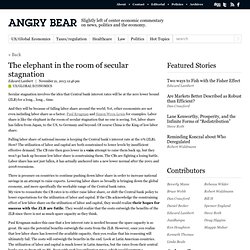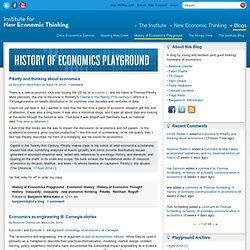

The elephant in the room of secular stagnation. Secular stagnation involves the idea that Central bank interest rates will be at the zero lower bound (ZLB) for a long… long… time.

And they will be because of falling labor share around the world. Yet, other economists are not even including labor share as a factor. Paul Krugman and Simon Wren-Lewis for examples. Labor share is like the elephant in the room of secular stagnation that no one is seeing. Yet, labor share has fallen from Japan, to the US, to Germany and beyond. Falling labor share of national income is keeping the Central bank’s interest rate at the 0% (ZLB). There is pressure on countries to continue pushing down labor share in order to increase national savings in an attempt to raise exports. Paul Krugman makes this case that a low interest rate is needed because the spare capacity is so great.
Central banks must fit their rate policy to the new lower range of labor and capital utilization. The truth is hard to accept, especially this truth of secular stagnation. More supply of money to Capital thanks to Fed. Looking at the Consumption rate of Capital Income. Theoretically, capital income, especially in the form of retained earnings by corporations and some capital gains would be used for saving and investment in the means of production, while labor income is used for consumption of finished goods and services from production. However, a portion of capital income is used for consumption, when the incentives and extra liquidity are there.
What is the percentage of capital income that is used for consumption of finished goods and services? And is it helpful to know? Here is the graph I put together showing the changes in the consumption rate of capital income since 1953… Link to Graph #1. The consumption rate of capital income reached 40% in the 1960s and then fell to almost 0% during the 1980 recession. Well, as I inputted decades of data using dozens of sheets of paper, patterns appear.
Link to Graph #2. Then in 1967, the effective tax rate for capital income began to rise, while the effective tax rate for labor income began to fall. History of Economics Playground. Economists' macro stories The last straw in the enduring blog debate over microfoundations has taken a decisive historical turn.

Last December already, Paul Krugman gave his own account of how microfoundations came to be the 70s, and why they unduly spread over subsequent decades, and so did Stephen Williamson. Economists' need to ground their methodological debates into self-made historical narratives is in itself an interesting feature for historians. But in a recent post dealing with the “Faustian bargain” New Keynesians may have sealed by endorsing of the New Classical microfoundational program, Simon Wren-Lewis asked a more direct historical question: Is this how it happened?
And Noah Smith added a second one: “are macroeconomists doomed to always 'fight the last war'? It thus seems the kind of narratives economic bloggers are after are of two kinds: “How did they ever think to put all these pieces together in just this way? " How to win a science war? The rise of economics as engineering I : setting the scene.
The rise of the economist as engineer is, economists and historians say, an essential characteristic of the development of economics in the postwar period.

In 2006, Greg Mankiw wrote a much commented paper in which he argued that one brand of macroeconomics (neokeynesian) is akin to engineering, by which he meant “solve practical problem,” and “help policmakers devise better policies to cope with the Business Cycle.” Another brand is rather done by (new classical) scientists, he explained, and is about “propos(ing) and test(ing) elegant theories.” He traced the first tradition to Keynes, its theoretical reformulation by Hicks and Modigliani, to the large-scale applied macromodels of Klein, Eckstein and Ando-Modigliani, and to the neo-keynesians. The second stream of course reflects the Lucas-Sargent-Wallace-Kydland-Prescott family tree. Such broad narrative can be supplemented by bringing into the picture those economists who explicitely considered themselves as engineers.